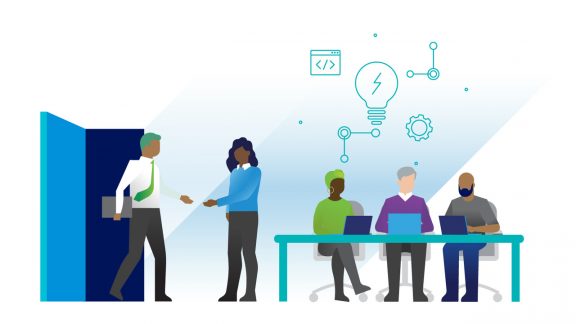Co-Authors: Norman Dee and Mark Scott
In the first blog in this series, we discussed the importance of planning human change management when implementing material technology changes within an organization to ensure the ongoing adoption and success of those changes.

These ten steps are key to establishing a common vision, change framework, provisioning resources, determining budgets, metrics & KPIs and designing the change plan based on the type of change taking place. In this second blog of the series, we will discuss the types of changes that might occur and what the impact is on the human side of the equation.
In the third, final blog of the series, we will discuss implementing a human change management program.
Defining the Change Vision
In this first critical step of defining the vision, we need to decide:
- What are we trying to accomplish? What is the purpose of the program or project? For example, “We will provide all of our customer services through the cloud.”
- Why are we doing it? What is driving this need for change? What are the business drivers for the change? What are the environmental factors leading to this change? In the above vision, that reason could be “to leverage limitless international resources.”
- What needs to be changed? What technologies, processes, organizations will have to change? At the same time, we have to keep in mind the guardrails around the changes. What regulations, ethics, corporate directions need to be taken into account to determine what has to be changed. Following our example, these changes can be those internal applications and systems that need to migrate to the cloud.
- Who will be affected by the change? Who are the people and teams supporting the systems that will migrate to the cloud? What will their new roles be?
If people don’t change how they do their job, the change will ultimately fail to be adopted. Getting them to be part of the successful effort requires presenting a clear vision, in which both the individuals’ input and the organization’s perspectives are addressed.
Types of Changes
The type of change has a major impact on the effort and funding needed to manage the shift. Here are few common types of change categories:
- Policy and process changes are largely notational. They often involve the realigning of resources within the context of the status quo organization. These may be as simple as an addendum to current policies or up to the formal institutionalization of a new major policy. They usually require additional training and communications efforts. Process changes can be more extensive. In this context, we refer to the updates to processes already in place and not the implementation of new ones.
- System changes, especially when it comes to new systems, processes, or major automation efforts, can be more impactful. Here is where a whole new service organization can support a new system or the re-apportionment of FTE hours from a current one due to automation. New and transition roles will have to be defined, HR guidelines taken into consideration, communication plans established, and change project metrics and KPIs tracked. Needless to say, this change can be costly.
- Organizational change impacts depend on the level of those changes. Re-aligning lower-level groups across different higher-level organizations have a relatively low impact on employees other than Employee Satisfaction (ESAT) ratings. Communication is critical to ensure that employees feel aware and invested in these changes. Just announcing what some may perceive as a “coup d’état” can result in a “we lost, they won” sentiment. Hence, the impact on ESAT.
- Job role changes are usually minor, sub-change projects to address the specific impacts on a job due to policy, system, organization, redundancies, or mergers and acquisitions. Though they may be seemingly minor, they can be the primary source of resistance, especially with longer-term employees. Directly communicating with the affected employees about why this is personally good for them, how they fit in, their career, etc., is a way to mitigate this risk.
- Staffing level changes usually refer to the downsizing of staff. The change management impact can be extensive and expensive. Think about situations where downsizing has to maintain morale, pay transitional staff stay-around bonuses, ensure that strategic employees don’t leave through additional bonus programs, and pay departing employees benefits. These departing benefits can include long-term incentive option cash-ins, outside job counseling services, severance payments and legal issues. Planning for these changes, often managed by HR specialists, needs to be detailed and the total cost planned.
- Strategy changes can be tumultuous but at a slower rate. Think of a company that says, “we will move everything to the cloud,” or “we will provide IT as a service,” or “we will add a new business line.” These are strategies that may not be complete in 24 hours but over time. These require excellent communication plans relaying the vision, strategy and everyone’s role in those changes. Details often follow and should do so at a regular cadence. There needs to be open dialogue and transparency to ensure the success of the strategy. The impact on job roles, staffing levels and the organization need to be determined and properly funded. The staff need to be given time to prepare and train for their new roles.
- Acquisitions, mergers and divestitures are very different from Strategy changes. Often, Mergers and Acquisitions are announced as fait accompli, i.e., a done deal. Ideally, they have been carefully planned, have the integration (or spin-off) determined and have a budget to complete the plans. That’s the ideal. In reality, these are usually afterthoughts. More likely, you’ll find needs to reconcile redundant systems, functions, lines of business and the impact on employees. Change management is typically proactive, but in the case of mergers, it can be reactive and involve some damage control to reach desired outcomes. This doesn’t change the steps needed but often requires reverse engineering of the vision and a more intense level of communications.
For each type of change, we need to determine the impact and timing. Based on the previous insights, you should be able to decide on the amount of change, and the timeframe for that change will play a significant role in your change management planning.
- Large changes require a high degree of change management and are very “front-end” loaded with many activities to prepare employees for the change. Top/Down and Bottom/Up synchronization is needed requiring leadership at all levels to be informed and consistent in understanding and communicating. The Change Management plan needs to ensure continuity in messaging at all leadership levels to the affected roles and personnel.
- Incremental changes that occur over a long period require a different strategy – one that is at a lower-level and more persistent.
Change Metrics
Step three requires a deeper look into the importance of metrics and key performance indicators (KPIs). Outside of the obvious financial metrics, here are some key metrics needed to measure the impact of human change management:
- Speed of adoption is an important KPI in which we will know how quickly people are up and running on the new systems, processes and job roles. Source metrics for this KPI can be HR records showing role changes, education records showing completion of courses and certifications.
- Ultimate utilization, consumption or employee buy-in, lets us know how successfully we have won those involved. Consumption of new processes and services can be measured through the logging and tracking of workflows, service catalogs and requests. Indirect source data is usually survey-based. Unplanned employee turnover rate would also be an indication.
- Proficiency, a KPI indicating how well individuals perform compared to previous levels, can be determined by like-to-like comparisons of previous and current workloads and backlog velocity. Of course, these are dependent on the roles and types of technology in play.
For the most part, these are lagging indicators. They let us know how well we have done. Leading indicators track the opportunities for success in the future and measure things like the number of courses available to employees, numbers of employees in training, communications/marketing programs planned, and so on. Defining lagging indicators is much easier than defining leading ones. But, if you think of measuring those things you are doing to enable the change, leading indicators can more accurately predict successful outcomes. The following additional metrics (#s) and KPIs (%’s) are recommended as a starter set:

The Human Perspective Summary
People make or break change. The human change process helps employees transition from the current state to the future state with minimal productivity loss, negative customer impact and employee turnover while maximizing the organization’s speed of adoption. There are two perspectives:
- The individual perspective is how people experience change. Tools like communication, sponsorship and coaching help employees make their individual transition and embrace their roles.
- The organizational perspective is how groups are managed through a change. Business results are only achieved when employees are involved and participating in the change. The best plans fail if the executing participants don’t support the change.
Employees can be resistant to change. This is why communication plays a significant role in achieving success. It’s critical to vocalize a clear path forward with support and training provided along the way. This effort can significantly impact your bottom line by maximizing productivity and reducing turnover.
Human change management is a serious component of projects that should be carefully planned, communicated, funded and tracked. The next blog in this series will discuss the implementation and management of a human change program.

Mark Scott
Mark is a keen and passionate virtualization expert who excels at designing and delivering cloud-based infrastructure projects, to schedule and budget. He is visionary in his design and knowledge and ensures that details and scope are fully defined and wholly explored prior to and throughout the lifecycle of the project.





